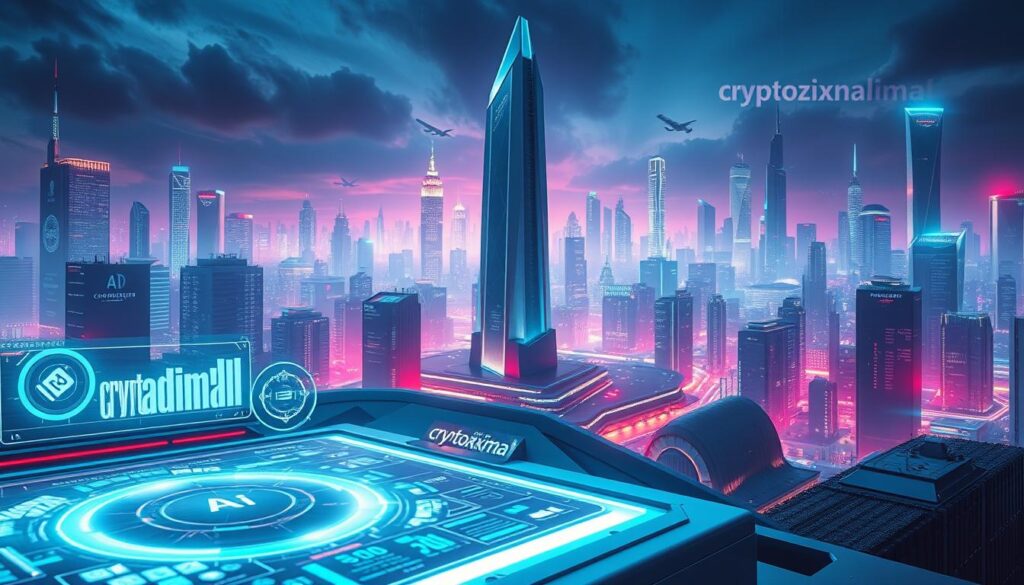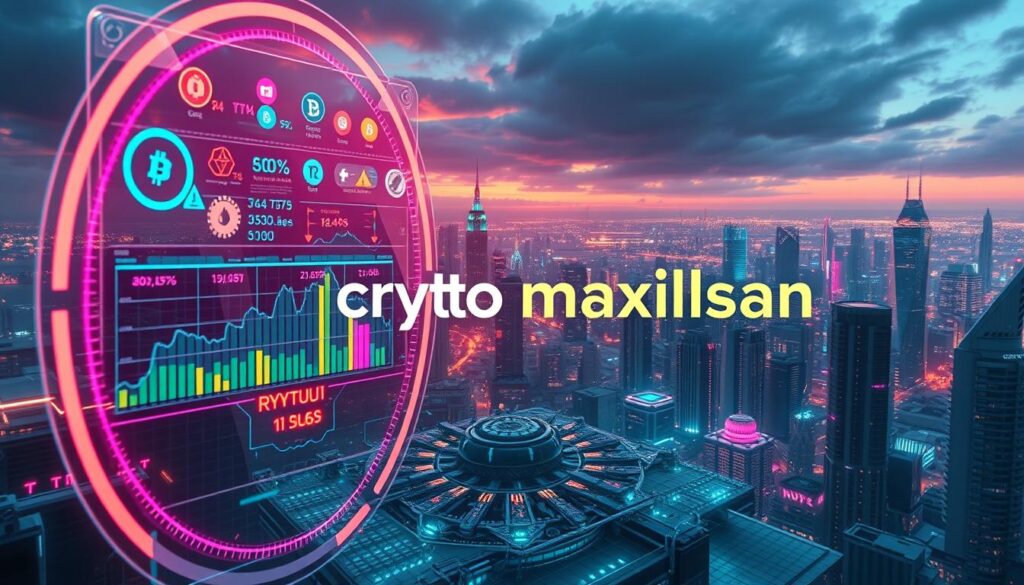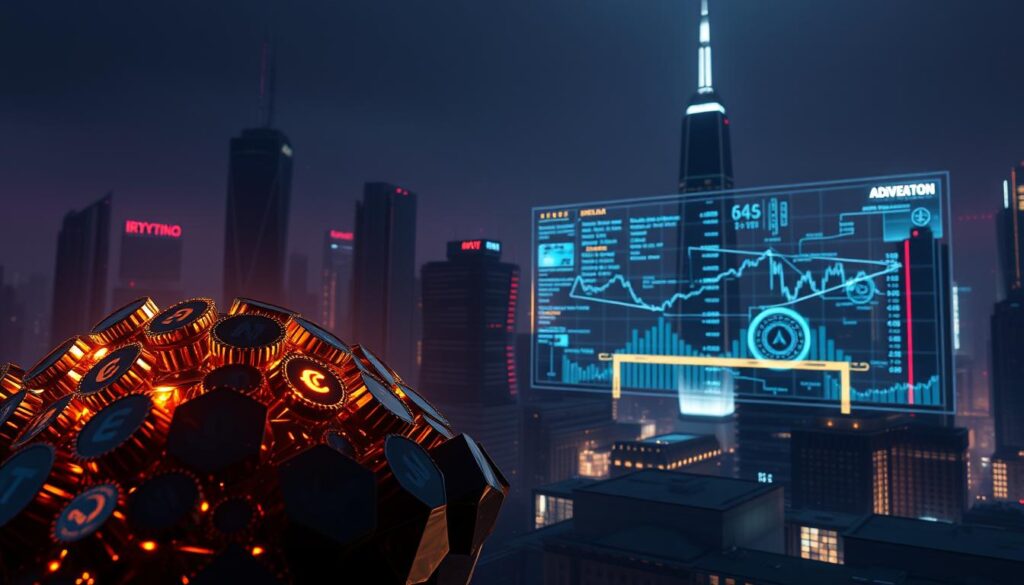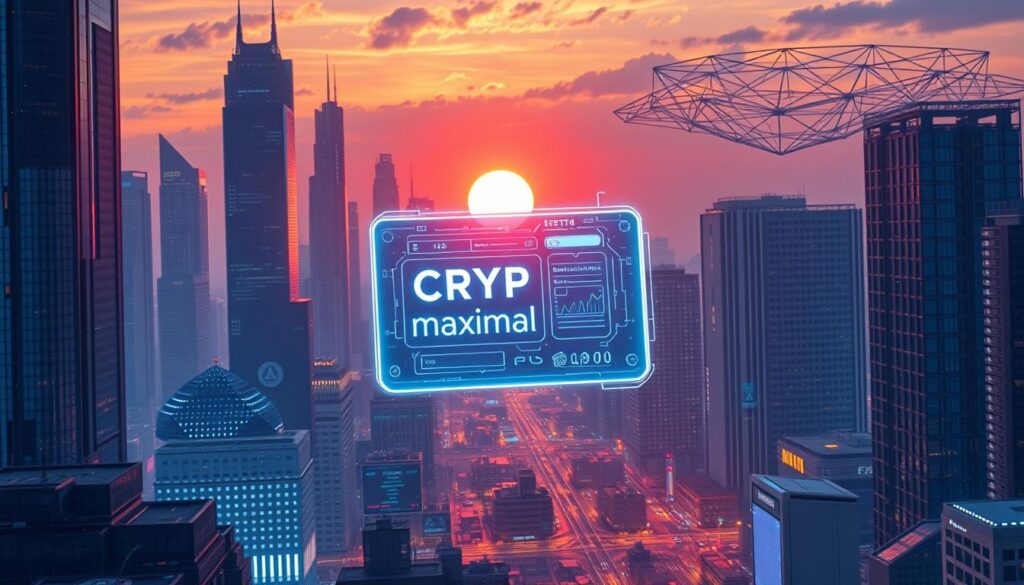The fusion of advanced computing and decentralized networks is reshaping finance. Projects combining machine learning with blockchain solutions now dominate conversations among forward-thinking investors. By mid-2025, this niche surged to a $24–27 billion valuation, proving its staying power in volatile markets.
These digital assets power diverse applications, from training neural networks to automating trading strategies. Market leaders have already crossed billion-dollar valuations, reflecting confidence in their real-world utility. Unlike traditional coins, they often provide tangible services like data analysis or resource-sharing platforms.
Investors gain exposure to two disruptive fields simultaneously. Decentralized AI models reduce reliance on centralized tech giants, while blockchain ensures transparency. This dual advantage creates unique opportunities for those seeking long-term growth beyond conventional stocks or standard crypto holdings.
Key Takeaways
- AI-driven crypto projects reached $24–27 billion in total value by mid-2025
- Leading tokens offer services like decentralized computing and automated trading
- Combining blockchain with machine learning enhances security and efficiency
- Early adopters benefit from diversification across tech and finance sectors
- Research project fundamentals before allocating portfolio space
Overview of the AI Crypto Landscape
The intersection of machine learning protocols and distributed ledger systems has created a dynamic new asset class. As of mid-2025, this sector’s total valuation ranges between $24 billion and $27 billion – outperforming most traditional tech stocks during the same period.
Market Trends and 2025 Projections
Recent market trends reveal a pattern of rapid expansion followed by strategic consolidation. While early 2024 saw speculative spikes, current valuations reflect more sustainable growth metrics. Projects like Render Token and Ocean Protocol now demonstrate consistent utility through decentralized computing markets.
| Project | Focus Area | 2025 Growth |
|---|---|---|
| Bittensor | Decentralized ML Models | 42% YTD |
| Fetch.ai | Autonomous Agents | 31% YTD |
| Akash Network | GPU Sharing | 58% YTD |
| The Graph | Data Indexing | 27% YTD |
Key Drivers of AI and Blockchain Convergence
Three primary forces fuel this merger of cutting-edge technologies:
- Demand for secure, decentralized data marketplaces
- Need for distributed computing power to train complex models
- Emergence of tokenized incentive systems for AI development
Institutional investors now allocate 6-9% of their digital asset portfolios to these hybrid projects, according to recent market analysis. This shift validates the sector’s potential beyond speculative trading.
Current developments focus on practical applications like decentralized neural networks and automated trading algorithms. These innovations address real-world needs while maintaining blockchain’s transparency advantages.
Understanding AI and Blockchain Integration
The synergy between intelligent algorithms and decentralized networks is unlocking unprecedented capabilities. This fusion addresses critical challenges in data security and resource allocation while creating self-governing ecosystems. By 2026, experts predict these systems will power over 35% of advanced computational tasks.
How Intelligent Systems Transform Digital Tools
Automated trading algorithms now process market patterns 12x faster than human traders. Fraud detection systems powered by machine learning reduce false positives by 40%, according to recent industry reports. These advancements optimize network performance while maintaining transparent decision-making processes.
Decentralized storage solutions ensure training data remains unaltered. This prevents bias in predictive models and allows third-party verification. Developers leverage these features to build trustless environments for sensitive operations.
Powering Innovation Through Distributed Frameworks
Global GPU-sharing networks cut cloud computing costs by 60% compared to centralized providers. Resource distribution enables startups to access enterprise-level processing power. Communities collectively maintain these platforms through tokenized incentives.
New marketplaces let users monetize datasets while retaining ownership. Smart contracts automatically execute payments when AI models achieve predefined accuracy thresholds. This approach fosters collaboration between data scientists and infrastructure providers without intermediaries.
Exploring “Best AI Cryptocurrencies To Buy”
Identifying standout projects in this evolving space demands a strategic approach. Investors prioritize tokens solving concrete challenges through technical innovation rather than hype-driven claims. Four key factors separate leaders from competitors: functional utility, scalability, team expertise, and measurable adoption.

Defining the Selection Criteria and Use Cases
Top candidates demonstrate active roles in machine learning workflows or data ecosystems. Some facilitate decentralized computing power sharing, while others enable secure trading of specialized datasets. Projects like those detailed in this analysis often combine blockchain’s transparency with predictive algorithms for smarter resource allocation.
Practical applications range from automating complex trades to optimizing energy use in data centers. For example, certain crypto assets power GPU networks that reduce rendering costs for generative art tools. Others create marketplaces where developers train neural networks using crowdsourced data.
Benefits of Integrating AI with Market Tokens
Combining adaptive algorithms with digital assets unlocks unique advantages. Predictive models analyze liquidity patterns to stabilize token values during volatility. Automated systems execute trades at optimal moments, bypassing emotional decision-making.
Security improvements stand out as another major benefit. Intelligent threat detection systems monitor transactions 24/7, identifying suspicious activity faster than manual reviews. These integrations create more resilient networks while offering tangible value to holders.
Tokenized incentives drive participation in AI development communities. Contributors earn rewards for sharing computing resources or verifying data accuracy – fostering ecosystems where technology and economics align seamlessly.
Product Roundup: Top AI Token Picks for Investors
Decentralized networks offering machine learning solutions are attracting serious capital in 2025. Four projects stand out for their technical innovation and measurable adoption rates. Each combines specialized services with transparent blockchain frameworks.

High-Performance Digital Assets
Bittensor’s TAO token leads with a $3.2 billion valuation, powering a peer-to-peer marketplace for AI models. Artists and developers access its decentralized GPU network for rendering complex 3D designs. The platform processes transactions 18% faster than centralized alternatives.
Render Token connects creative professionals with underutilized computing resources. Its $1.78 billion market cap reflects growing demand in gaming and medical visualization sectors. Users earn rewards through a proof-of-render system.
Valuation Trends and Liquidity Patterns
Recent trading data shows billion-dollar tokens maintaining strong liquidity. The Artificial Superintelligence Alliance trades at $0.63 with $1.5 billion valuation, supporting cross-chain communication tools. Its 24-hour volume averages $38 million across major exchanges.
Despite price fluctuations, The Graph remains essential for blockchain data queries. The $915 million project indexes information from 35+ networks. Analysts note its correlation with decentralized app development cycles.
Market leaders demonstrate three shared traits: active developer communities, clear revenue models, and multi-industry partnerships. These factors help maintain stability during broader crypto volatility while attracting institutional interest.
Deep Dive into Leading AI Crypto Projects
Advanced blockchain architectures are redefining how artificial intelligence operates in open ecosystems. Three projects stand out for their technical frameworks and community-driven growth strategies. Each combines specialized protocols with real-world applications across multiple industries.

Core Infrastructure Builders
SingularityNET ($0.28 | $335M market cap) pioneers decentralized artificial general intelligence development. Its open-source platform lets developers collaborate on neural network models while maintaining community governance through token voting. Over 45,000 contributors currently participate in its ecosystem.
NEAR Protocol ($2.73 | $3.06B) uses sharding technology to split its network into parallel chains. This approach reduces energy use by 67% compared to traditional blockchains. Developers building AI-powered apps benefit from instant transaction finality and low fees.
| Project | Key Feature | Active Nodes | Data Processed |
|---|---|---|---|
| SingularityNET | AGI Development | 8,900+ | 14.7 PB |
| NEAR Protocol | Sharded Network | 21,400+ | 89M Transactions/Day |
| The Graph | Data Indexing | 34,200+ | 1.2B Queries/Day |
Economic Models Driving Adoption
The Graph ($2.68B valuation) demonstrates how data infrastructure becomes valuable. Its indexing protocol processes over 1 billion daily queries for decentralized applications. Curators earn tokens by identifying high-quality information sources.
Token distribution strategies significantly impact long-term success. NEAR allocates 30% of supply to developers building on its platform. SingularityNET uses 18% of transaction fees to fund ongoing research – creating self-sustaining innovation cycles.
Community participation remains critical. Projects with active governance forums see 40% faster update deployment. Transparent roadmaps and developer grants help maintain engagement across these decentralized networks.
Emerging Innovations in AI Crypto Projects
Cutting-edge developments are redefining how decentralized systems interact with intelligent algorithms. These advancements create novel ways to analyze markets and automate complex tasks while maintaining blockchain’s security standards.

New Market Players and Growth Potential
Virtuals Protocol’s AIXBT token exemplifies emerging opportunities. Launched in late 2024, this digital asset powers agents tracking 400+ crypto influencers across social platforms. Despite dropping from its $0.95 peak, the $145-170 million valuation suggests room for recovery.
| Project | Focus | Market Cap | Key Feature |
|---|---|---|---|
| AIXBT | Sentiment Analysis | $170M | Real-time trend detection |
| Virtuals Protocol | Agent Creation | $1.7B | 21,000+ tokenized workers |
| Artificial Superintelligence Alliance | Collaborative Development | N/A | Multi-project integration |
Groundbreaking Technical Advancements
Platforms now enable machine learning models to evolve through community input. One protocol uses decentralized governance to adjust trading algorithms based on performance metrics. These systems reduce reliance on centralized data sources while improving accuracy.
Tokenized digital workers represent another leap forward. Developers build specialized agents for tasks ranging from market analysis to content moderation. Each contributor earns rewards proportional to their tool’s adoption rate.
The Artificial Superintelligence Alliance accelerates progress through shared resources. Multiple teams collaborate on neural networks that power prediction markets and automated research tools. This approach combines specialized expertise while maintaining transparent operations.
Investor
Navigating this evolving market demands careful planning. Savvy participants balance technical potential with realistic risk assessments. Projects demonstrating clear use cases and active developer communities often show greater resilience during market shifts.
Diversification remains critical. Allocate portions of holdings across machine learning infrastructure providers and data-driven platforms. This approach spreads exposure while capturing growth in multiple tech sectors.
Monitor protocol upgrades and partnership announcements closely. Networks expanding into healthcare or energy sectors frequently gain momentum. Set alerts for token release schedules to avoid dilution risks.
Long-term success often hinges on practical applications. Prioritize assets solving real-world problems like computational shortages or biased datasets. While volatility persists, decentralized tools reshaping industries could deliver outsized rewards for patient stakeholders.


No comments yet